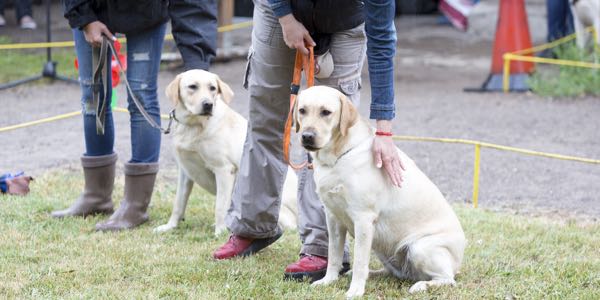What is a Guide Dog Trainer?
A guide dog trainer is someone whose purpose is to select and train suitable dogs for the blind or visually impaired, as well as to select and train each client in the use of the guide dog. The dogs that are selected are given initial training, then taken on to the advanced training stage which takes five to eight months.
A guide dog trainer needs to be physically fit, as he or she will be walking nearly all day and in all types of weather. It is also very stressful mentally, so the trainer needs to have patience, self-control, tact, perseverance, and a sense of humour. The guide dog trainer will match the visually impaired client with a guide dog, take them both through a series of classes, and make sure the dog and the new owner develop confidence in each other. After graduating, the guide dog trainer will visit the dog and new owner in their home to make sure that both are doing well.
Get online training through our partner:
What does a Guide Dog Trainer do?
A guide dog trainer has the responsibility of training dogs to work as guides to people with disabilities. These dogs help people gain independence and mobility. They assist people through traffic, judge the height and width of obstacles, and are able to assess danger in situations. The most common types of breeds to become guide dogs are german shepherds, labrador retrievers, and golden retrievers. It takes a special kind of dog to become a guide. They must have a calm and patient temperament and not be skittish around noises or crowds.

There are two phases of guide dog training that someone can become involved in:
Puppy Training
- Training a dog begins at a very basic level. Once a puppy is able to leave its mother, it is placed in a home where the puppy is taught basic obedience skills, how to socialize, and how to respond to commands such as “sit”, “stay”, and “come.” These trainers are typically volunteers who raise the puppies in their own home. The trainer must also expose the puppy to busy places such as crowded streets and other homes. This will determine if the puppy is fit to move on to more advanced training.
The people that train these dogs must be very patient and always make sure to reinforce behaviours that will make the dog an excellent guide. This stage lasts until the puppy is 12–14 months old. At that time, if it is suited for further training, the puppy will leave the volunteer's care and begin its coaching with a professional trainer.
Dog Training
- After the dog has learned the basic skills, a professional trainer coaches the puppy for two to three months. In the trainer’s care, the dog will learn how to behave well in public places such as restaurants, parks, shops, and public transit. They will also learn how to ignore distractions, such as other animals. Once they’ve mastered these skills they can move onto more advanced skills such as recognizing obstructions and leading the owner away from them. This includes less obvious obstacles like low hanging branches.
The dogs also learn “intelligent disobedience” which is where they learn not to obey commands if it leads their owners into dangerous situations, such as walking into traffic. The techniques used to train the dogs include positive reinforcement where they are given praise and food for a job well done, or through clicker training, which teaches them skills such as walking in a straight line, dealing with crowds, and stopping at curbs.
Once a dog completes this training, he or she is then paired with an owner for additional training. The owner and service dog should be a compatible match, since they will be together for the next ten years or more. Once the dog reaches retirement age, the original family may keep him or her. If not, the dog will go back to the training school where they will arrange adoption to a new family.
Guide Dog Trainers are also known as:
Service Animal Trainer
Seeing Eye Dog Trainer
Guide Dog Mobility Instructor